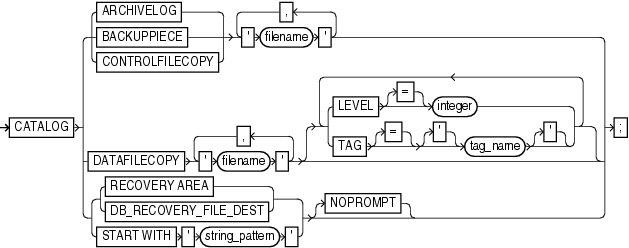| Oracle® Database Backup and Recovery Reference 10g Release 2 (10.2) Part Number B14194-03 |
|
|
View PDF |
| Oracle® Database Backup and Recovery Reference 10g Release 2 (10.2) Part Number B14194-03 |
|
|
View PDF |
Syntax
catalog::=

Purpose
Use the CATALOG command to do the following:
Add backup pieces and image copies on disk to the RMAN repository.
Record a datafile copy as a level 0 incremental backup in the RMAN repository, which enables you to use it as part of an incremental backup strategy.
Record the existence of the last user-managed datafile copies made after the final shutdown in Oracle7, before migrating the database to Oracle8.
See Also:
Oracle Database Backup and Recovery Basics to learn how to manage target database records stored in the catalogRestrictions and Usage Notes
You must be connected to the target database, which must be mounted or open.
If RMAN is connected to a recovery catalog, then the catalog database must be open.
For a user-managed copy to be cataloged, it must be:
A datafile copy, control file copy, archived log, or backup piece.
Accessible on disk.
RMAN treats all user-managed backups as image copies. Note that during cataloging, RMAN does not check whether the file was correctly copied by the operating system utility: it just checks the header.
You cannot catalog any datafile copies that were created in Oracle7 unless they were made after the final consistent shutdown in Oracle7 and before running the migration utility, or were made of a tablespace that was offline normal or read-only at the time of the migration. In other words, it must be possible to use the Oracle7 datafile copies without applying any archived logs.
You cannot use CATALOG to catalog a file that belongs to a different database.
You cannot use CATALOG to catalog a backup piece that exists on an sbt device.
Keywords and Parameters
| Syntax Element | Description |
|---|---|
ARCHIVELOG 'filename' |
Specifies the filename of an archived log to be added to or updated in the RMAN repository. |
BACKUPPIECE |
Specifies the name of a backup piece to be added to the RMAN repository. The backup piece must be on disk. RMAN verifies the backup piece header before cataloging it. RMAN can catalog a backup piece from a prior incarnation.
Typically, you would catalog a backup piece in the following situations:
If you specify a list of backup pieces, RMAN attempts to catalog all pieces in the given list even if some of them fail. Cataloging a backup piece creates a new row in Note: When cataloging backup pieces from releases prior to Oracle9i, performance improves when you catalog higher copy numbers first. For example, if you need to catalog copies 1, 2, and 3 of a backup piece, then specify copy 3 as the first item in the |
CONTROLFILECOPY 'filename' |
Specifies the filename of a control file copy to be added to or updated in the RMAN repository. The control file copy can be:
|
DATAFILECOPY 'filename' |
Specifies the filename of a datafile copy to be added to or updated in the RMAN repository. |
LEVEL = 0 |
For datafile copies only, indicates that the copy should be recorded as a level 0 incremental backup. You can perform incremental backups by using this datafile copy as the base level 0 backup. |
(RECOVERY AREA |DB_RECOVERY_FILE_DEST) [ NOPROMPT ] |
Catalogs all valid backup sets, datafile copies, and archived redo logs in the flash recovery area. RMAN must be connected to the target database and the target database must be mounted or open. Specify NOPROMPT if you do not want to be prompted after every match. The keywords RECOVERY AREA and DB_RECOVERY_FILE_DEST are exact synonyms. |
START WITH 'string_pattern'
|
Catalogs all valid backups in locations that match the string pattern, which can be an Automatic Storage Management disk group, Oracle Managed Files directory, or part of a filename. RMAN will report any files in the disk location that cannot be cataloged. RMAN must be connected to the target database and the target database must be mounted. Specify NOPROMPT if you do not want to be prompted after every match.
If the string pattern specifies a filename, then it matches the left part of the filename pattern. For example, Note: You cannot use wildcard characters in the string pattern, only a strict prefix. |
Examples
Cataloging an Archived Redo Log: Example This example assumes that you made operating system copies of archived logs or transferred them from another location, and then added them to the RMAN repository:
CATALOG ARCHIVELOG '?/oradata/archive1_30.dbf', '?/oradata/archive1_31.dbf',
'?/oradata/archive1_32.dbf';
Cataloging a File Copy as an Incremental Backup: Example The following example catalogs datafile copy users01.bak as an incremental level 0 backup:
CATALOG DATAFILECOPY '?/oradata/users01.bak' LEVEL 0;
Note that you can create datafile copies either using the RMAN BACKUP AS COPY command, or by using operating system utilities in conjunction with ALTER TABLESPACE BEGIN/END BACKUP.
Cataloging Multiple Copies in a Directory: Example The following example catalogs a directory full of archived logs that were copied into the /tmp/arch_logs directory with an operating system utility:
CATALOG START WITH '/tmp/arch_logs';
Cataloging Files in the Flash Recovery Area: Example The following example catalogs all files in the currently enabled flash recovery area without prompting the user for each one:
CATALOG RECOVERY AREA NOPROMPT;
Cataloging Backup Pieces: Example The following example catalogs a backup piece that was copied with an operating system utility:
CATALOG BACKUPPIECE '?/oradata/01dmsbj4_1_1.bcp';